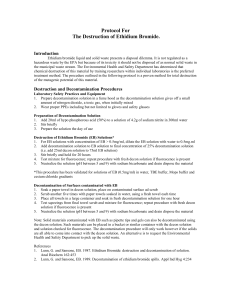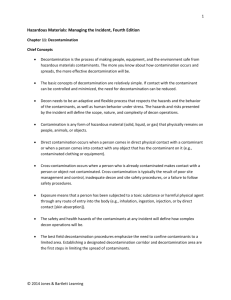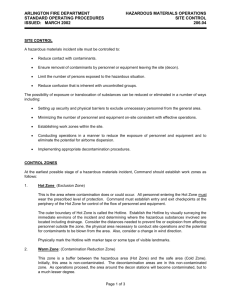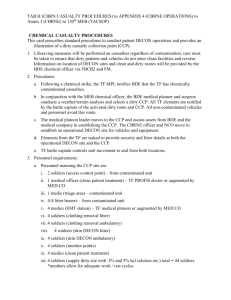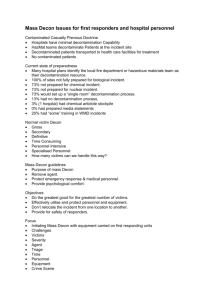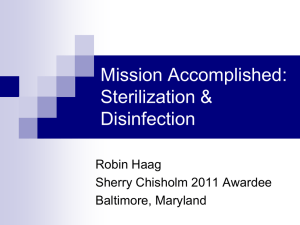Module 4: Standardized Decontamination Procedures
advertisement
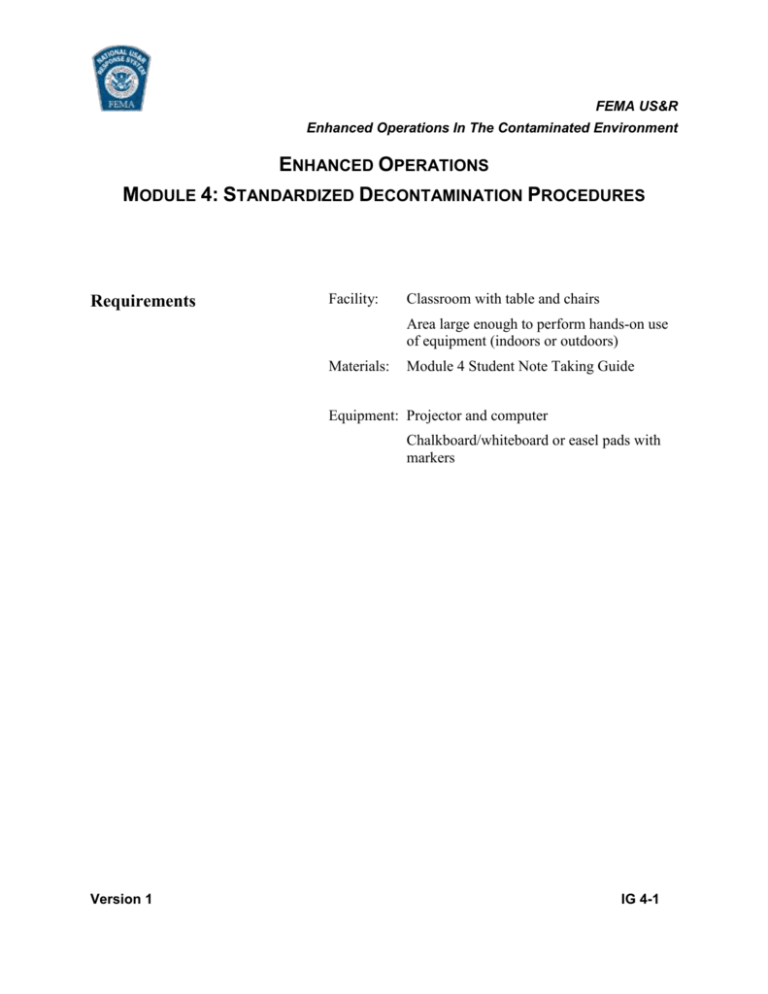
FEMA US&R Enhanced Operations In The Contaminated Environment ENHANCED OPERATIONS MODULE 4: STANDARDIZED DECONTAMINATION PROCEDURES Requirements Facility: Classroom with table and chairs Area large enough to perform hands-on use of equipment (indoors or outdoors) Materials: Module 4 Student Note Taking Guide Equipment: Projector and computer Chalkboard/whiteboard or easel pads with markers Version 1 IG 4-1 FEMA US&R Enhanced Operations In The Contaminated Environment National Urban Search & Rescue Response System Enhanced Operations in The Contaminated Environment Slide 4-1 Version 1 IG 4-2 FEMA US&R Enhanced Operations In The Contaminated Environment Slide 4-2 Terminal Objective At the end of this module the student will be able to describe the entire US&R decontamination process including the need for, types of, and the equipment required to perform decontamination. Slide 4-3 Enabling Objectives Students will define decontamination Students will identify the need for decontamination. Students will discuss the various types of decontamination Students will identify US&R decontamination equipment Students will describe staffing for the decontamination Version 1 Slide 4-4 IG 4-3 FEMA US&R Enhanced Operations In The Contaminated Environment system. Students will describe the decontamination process. Slide 4-5 Slide 4-6 Add overview Version 1 IG 4-4 FEMA US&R Enhanced Operations In The Contaminated Environment A. Decontamination Theory Overview Decon is time consuming. Chemical, Biological, Radiological, Nuclear or Explosive (CBRNE) event may involve hundreds or thousands of contaminated people. Decontamination planning and execution must be an integral part of any Urban Search and Rescue (US&R) WMD Task Force (TF) operations. All TF members and victims must be decontaminated prior to leaving the incident scene to keep task force personnel and the public as safe as possible and prevent spreading the problem. Slide 4-7 Decon is personnel and equipment intensive. Decontamination is time consuming Resources and personnel required will tax most communities. There is a need for: Tight scene control, Well-established zones, (hot, warm, and cold) Rapid decontamination methods, Control of runoff (if possible), Assigned personnel to work the decon lines. Decon should be conducted so that the least amount of evidence is destroyed. Version 1 The type of decontamination equipment is selected based on mission requirements, ie; the Hurricane decontamination IG 4-5 FEMA US&R Enhanced Operations In The Contaminated Environment reduction kit. etc… A working definition of decontamination is: “A chemical and/or physical process to remove and prevent the spread of a contaminant from an emergency scene because of the contaminant’s ability to cause harm to living beings and/or the environment.” Slide 4-8 Decontamination Prompt, safe, and effective decontamination procedures are essential to protect and/or reduce the effects of exposure; Develop procedures for team member and/or non-ambulatory victims; and Plan for medical decontamination such as, antidote administration and wound decontamination. Slide 4-9 E. . Decontamination Situations Normally the Tactical Operations Plan and the Decontamination Plan dictate decontamination. Decon is performed or driven by: Obvious contamination by a known substance; Suspected contamination by a known substance; Suspected contamination by an unknown substance Slide 4-10 Version 1 IG 4-6 FEMA US&R Enhanced Operations In The Contaminated Environment Any likelihood of exposure to a hazardous substance in the hot zone; To prevent spread of contaminant; or To ensure environmental protection. . Perform DECON by Priority TF Members and canines that are ill, symptomatic, or have compromised PPE Rescued survivors TF Members with intact PPE and canines that are asymptomatic Slide 4-11 A. Decontamination Process Some points to remember about decon are: Hazmat Specialists supervise decontamination process.; Primarily to protect Task Force Decontamination is always confirmed with monitoring equipment Survivor decontamination Everyone goes through some level of decontamination This provides protection against contamination spread to EMS, Hospitals, etc Slide 4-12 Protect TF members Version 1 IG 4-7 FEMA US&R Enhanced Operations In The Contaminated Environment . The types of decontamination are: Emergency Gross Decon o Field DECON Kit Technical o CPC o Personnel o Vehicles o Equipment o Canine Slide 4-13 Emergency Decontamination A fire hose at the point of Entry/Exit is an excellent choice. Field Decontamination Kit Design system as appropriate for the mission at hand Slide 4-14 Field Decontamination Kit: Packed in a Hardigg Box Include inventory of Field (Hurricane) Decontamination Kit. This DOES NOT replace any technical decontamination. Version 1 IG 4-8 FEMA US&R Enhanced Operations In The Contaminated Environment Slide 4-15 Technical DECON Multi Step Process Gross Wash Wash and Rinse Doffing of CPC and Respiratory Equipment Metering/Screening Medical assessment Personal Shower Slide 4-16 Technical Decontamination Equipment Buckets, brushes, and soap DECON solution and containment system Dedicated water supply Trash containers Slide 4-17 • Technical DECON Equipment (cont) • Electrical extension cords & water hoses • 600 gallons waste bladder Run-off and waste water pumps • Gross DECON showers • Modular DECON Tent Slide 4-18 Version 1 IG 4-9 FEMA US&R Enhanced Operations In The Contaminated Environment Technical DECON Equipment (cont) • Canopies/Tents • Air space heater • Water Heater • Generators • Tube lighting • Work lights Slide 4-19 Technical DECON Equipment, Cold Weather Use • Tents with Sidewalls Space Heater Hot water heater Zippers for entrance and exit May need and “Event Tent” if weather is severe to cover entire corridor IST or Local Jurisdiction help Slide 4-20 Water Heater Portable 60°F to 105°F + at 16 gpm Fuels - diesel, JP-4, JP-8, or kerosene Solid state ignition - ignites when water flows Onboard pressure reducing valve Slide 4-21 Version 1 IG 4-10 FEMA US&R Enhanced Operations In The Contaminated Environment Technical DECON Equipment Portable with wheels and handles Provides breathable heated air -110,000 btu output, 850 cfm fan Multi-fuel (kerosene, diesel, fuel oil, JP 4/8) 16 hours on 1 tank of fuel Slide 4-22 Specialized DECON Equipment MERLIN foam generator Sandia Foam may be available Hazmat Specialist can arrange for other solutions if needed Requires a 3 year service by manufacturer Slide 4-23 Standardized DECON Staffing DECON supervised by Hazmat Specialist DECON positions filled by any available personnel All Task Force members receive basic DECON training Medical Specialist conduct Triage Slide 4-24 Version 1 IG 4-11 FEMA US&R Enhanced Operations In The Contaminated Environment Decontamination Supervisor Responsible for final walkthrough of corridor Ensures supplies are present Addresses runoff containment Ensures safe, efficient and effective operations Slide 4-25 Medical DECON Liaison Responsible for medical assessment and treatment Liaison with DECON supervisor Positioned to observe all persons leaving the exclusion zone Slide 4-26 When assigned to DECON Don Selected level of PPE/CPC Operate in PPE/CPC Establish operating time Log Setup and operate DECON line Conduct triage Communicate while in PPE/CPC Slide 4-27 Version 1 IG 4-12 FEMA US&R Enhanced Operations In The Contaminated Environment Standardized TF DECON Site Layout Situated upwind from the exclusion zone Locate uphill, drain toward exclusion zone or off to side Place heaters upwind and uphill to help avoid contamination Plastic bags on hand to collect personal items Slide 4-28 Establish the decon corridor: Face into the wind with your back to the hot zone. Position so cold zone is upgrade or at least the water drains to the side. Place corridor close to the incident site with enough space for gross decon area, modular wash and rinse tent, doffing tent, personal shower, and Medical and Rehabilitation area. Space will also be required for the generators and heaters. Slide 4-29 Place close to water source from the city utility, lake, or stream. (The cleaner the better.) D. Establish the decon corridor: Version 1 Face into the wind with your back to the hot zone. 2.Position so cold zone is upgrade or at least the water drains to the side. Place corridor close to the incident site with enough space for gross decon area, modular wash and rinse tent, doffing IG 4-13 FEMA US&R Enhanced Operations In The Contaminated Environment tent, personal shower, and Medical and Rehabilitation area. Space will also be required for the generators and heaters. Version 1 Place close to water source from the city utility, lake, or stream. (The cleaner the better.) On hand for collecting personal possessions and for contaminated items. Ideal site has low-lying area to collect contaminated runoff. Dispose of collected water in accordance with EPA regulations. Use traffic cones and highly visible tape to cordon off the area except for those passing through decon. Establish warning signs to keep people away except for those who need to be decontaminated. Injured patients will process through the decon site. They will not be taken to the hospital until the Hazmat Specialist verifies decontamination. Your decon plan must be flexible enough to establish a decon corridor in various situations. Slide 4-30 IG 4-14 FEMA US&R Enhanced Operations In The Contaminated Environment US&R Standard DECON Process Step One – Gross DECON (Shower) Step Two – Wash and Rinse Modular pre-plumbed 3 lane shower Step Three – Remove Outer Protection Respiratory protection removed last Meter to determine DECON efficiency Step Four – Personal Hygiene Shower Slide 4-31 Step 1. Gross Decon Rinse thoroughly in shower Slide 4-32 Step 2. DECON Wash and Rinse Scrub clean ( helpers on hand) Person spread arms and legs, rotate for cleaning Slide 4-33 Version 1 IG 4-15 FEMA US&R Enhanced Operations In The Contaminated Environment Step 2, DECON wash and Rinse (cont) Wash from top down Assistants MUST DECON themselves before they leave the decontamination corridor. Slide 4-34 Step 3. Remove Outer Protection Remove CPC: not respiratory protection Place CPC in container for disposal Prevent cross contamination Turn CPC inside out as it is removed Peel CPC off rescuer without touching inside of CPC Remove respiratory Protection after leaving the area. Slide 4-35 Step 4. Personal Hygiene May be on or off site Personnel MUST be clean before evacuation Personal hygiene can range from hand washing to showering Slide 4-36 Version 1 IG 4-16 FEMA US&R Enhanced Operations In The Contaminated Environment Post DECON Monitoring Personnel exiting DECON checked with monitoring instruments by HazMat Specialist If contaminants still present after removing CPC, or working in known contaminants, then personal hygiene is high priority Slide 4-37 Post DECON Considerations Medical Evaluation Rehabilitation and replacement clothing Reports and exposure logs Hazmat tracking Slide 4-38 Water Run Off Consideration Collapsible berms Sump Pumps Water Bladder Plastic Sheeting The EPA position on runoff states that you can avoid capturing waste water in an emergent life safety situation Slide 4-39 Version 1 IG 4-17 FEMA US&R Enhanced Operations In The Contaminated Environment DECON Water Disposal Collected water should be removed by an appropriate agency(s) or contractor Ask for established policy as per DECON Plan IST EPA Slide 4-40 SUMMARY Decontamination Theory Standard Plan Provide protection to all Hazmat Specialist coordinates DECON Emergency DECON is four steps DECON Layout Review and Examination Module 4 Activity: Setup and Operate the DECON Corridor Slide 4-41 Slide 4-42 Slide 4-42 Version 1 IG 4-18 FEMA US&R Enhanced Operations In The Contaminated Environment Activity Layout containment berms Assemble tents and showers Setup and operate water heater Setup and operate space heater Walk through the DECON process Slide 4-43 Version 1 IG 4-19
